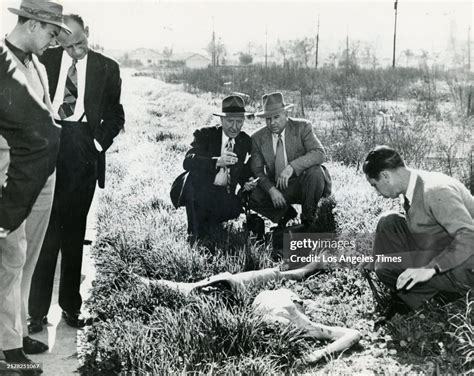The Black Dahlia murder is one of the most infamous and intriguing crimes in American history. The brutal murder of Elizabeth Short, a 22-year-old woman, took place in Los Angeles, California, in 1947. The crime scene, which was discovered on January 15, 1947, was a gruesome and shocking spectacle that would haunt the city for decades to come. In this article, we will delve into the uncovered facts of the Black Dahlia crime scene, exploring the details of the case and the investigation that followed.
Introduction to the Case
Elizabeth Short, a young woman with a troubled past, was found murdered in a vacant lot on Norton Avenue in the Leimert Park neighborhood of Los Angeles. Her body was discovered by a local resident, Betty Bersinger, who was walking with her three-year-old daughter. The police were immediately called to the scene, and an investigation was launched. The crime scene was a pivotal part of the investigation, providing crucial evidence that would shape the course of the case.
The Crime Scene: A Grisly Discovery
The crime scene was a shocking and disturbing sight. Elizabeth Short’s body was found with evidence of severe torture and mutilation. She had been cut in half at the waist, and her face had been cut from the corners of her mouth to her ears, creating a grotesque, “Glasgow smile.” Her body had also been subjected to various forms of torture, including cigarette burns and bruises. The crime scene was meticulously examined by the police, who collected evidence, including fingerprints, footprints, and fibers.
Investigation and Evidence
The investigation into the Black Dahlia murder was one of the largest and most extensive in Los Angeles history at the time. The police interviewed hundreds of suspects and followed up on numerous leads, but the case remained unsolved. The evidence collected from the crime scene, including the fingerprints and footprints, was analyzed, but no matches were found. The police also discovered a series of cryptic messages and symbols at the crime scene, which were believed to be linked to the killer.
Theoretical Perspectives
Over the years, numerous theoretical perspectives have emerged regarding the Black Dahlia murder. Some believe that the killer was a serial murderer, while others think that the crime was committed by someone close to Elizabeth Short. The investigation has also been criticized for its handling of the case, with some arguing that the police were too focused on the sensational aspects of the crime, rather than following up on leads and gathering evidence.
Expert Insights
To gain a deeper understanding of the Black Dahlia case, it is essential to consult with experts in the field. Dr. George Hill Hodel, a former Los Angeles doctor, has been linked to the crime, and his son, Steve Hodel, has written extensively on the subject. According to Steve Hodel, “The Black Dahlia case is a complex and multifaceted crime that requires a detailed and nuanced understanding of the evidence and the investigation.” Dr. Hodel’s insights provide valuable context to the case, highlighting the importance of careful analysis and consideration of all the evidence.
Comparative Analysis
The Black Dahlia case can be compared to other infamous murders, such as the Zodiac Killer and the Jack the Ripper cases. These cases share similarities with the Black Dahlia murder, including the brutal nature of the crimes and the lack of concrete evidence. A comparative analysis of these cases can provide valuable insights into the minds of serial killers and the investigative techniques used to solve these crimes.
Future Trends and Implications
The Black Dahlia case has significant implications for the field of criminology and forensic science. The case highlights the importance of careful evidence collection and analysis, as well as the need for a nuanced understanding of the complexities of human behavior. As technology continues to evolve, it is likely that new evidence will come to light, shedding further light on the case. The Black Dahlia case serves as a reminder of the importance of perseverance and dedication in the pursuit of justice.
Conclusion
The Black Dahlia crime scene is a complex and intriguing topic that continues to fascinate people to this day. The uncovered facts of the case provide a glimpse into the brutal and disturbing nature of the crime, as well as the extensive investigation that followed. By examining the evidence, theoretical perspectives, and expert insights, we can gain a deeper understanding of the case and its significance in the context of American true crime history.
What was the significance of the Black Dahlia case?
+The Black Dahlia case was a highly publicized and infamous crime that highlighted the brutal and disturbing nature of serial murder. The case also raised questions about the handling of the investigation and the treatment of victims and their families.
Who was the main suspect in the Black Dahlia case?
+Dr. George Hill Hodel was a former Los Angeles doctor who was linked to the crime. His son, Steve Hodel, has written extensively on the subject and has provided valuable insights into the case.
What were some of the challenges faced by the investigators in the Black Dahlia case?
+The investigators faced numerous challenges, including the lack of concrete evidence, the handling of the crime scene, and the sensationalized media coverage. These challenges made it difficult for the investigators to follow up on leads and gather evidence.
What is the current status of the Black Dahlia case?
+The Black Dahlia case remains unsolved, but new evidence and technological advancements continue to shed light on the case. The case serves as a reminder of the importance of perseverance and dedication in the pursuit of justice.
How has the Black Dahlia case impacted the field of criminology and forensic science?
+The Black Dahlia case has significant implications for the field of criminology and forensic science. The case highlights the importance of careful evidence collection and analysis, as well as the need for a nuanced understanding of the complexities of human behavior.
What can be learned from the Black Dahlia case?
+The Black Dahlia case provides valuable lessons about the importance of careful investigation, the need for a nuanced understanding of human behavior, and the impact of sensationalized media coverage on the investigation. The case also serves as a reminder of the importance of perseverance and dedication in the pursuit of justice.



